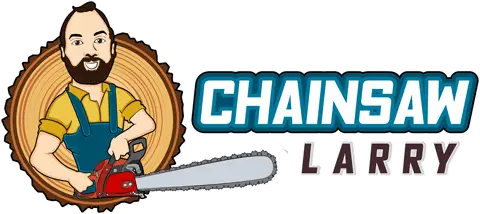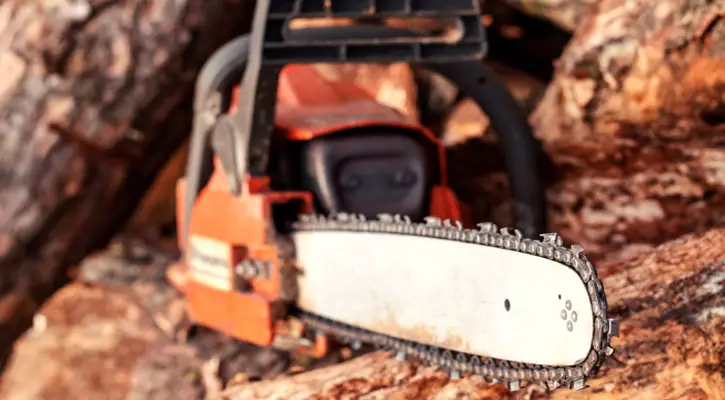Table of Contents
Are you new to using a chainsaw?
Are you wondering- what is chainsaw kickback?
Would you also like to know how to avoid a kickback injury?
If so, you’re in the right place.
I put this article together to give you all of the information you need to use your chainsaw as safely as possible.
So, keep reading to discover what chainsaw kickback is and how to protect yourself from it.
What is Chainsaw Kickback?
The term “kickback” is used to describe the sudden, upward motion of a chainsaw’s guide bar.
Believe it or not, but it’s one of the most common causes of accidents that happen with a chainsaw, and it’s usually caused by not using proper chainsaw cutting techniques.
Kickback can happen in the blink of an eye too.
It’s incredibly dangerous and could result in a serious injury that could send you to the hospital
In fact, about 30,000 chainsaw-related injuries happen each year, with chainsaw kickback accidents being the most common hazard.
What Causes Chainsaw Kickback?
In general, there are three situations that cause chainsaw kickback.
- The chain hits a hard object in the kickback zone.
- The wood pinches the chain in the middle of a cut.
- Other factors that contribute to chainsaw kickback.
1. The Kickback Zone
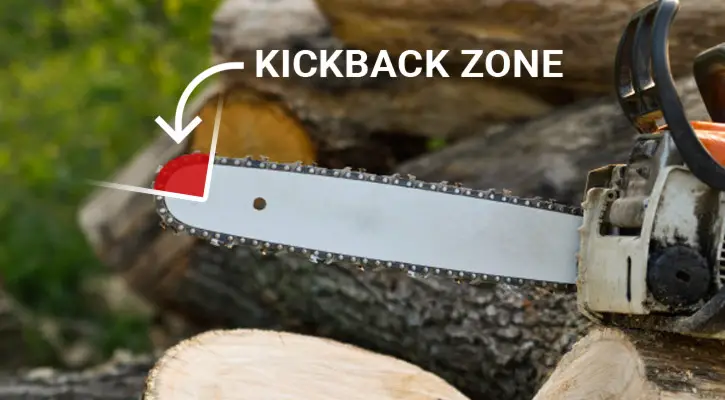
There’s one part of your chainsaw that’s referred to as the “kickback zone”.
The kickback danger zone is the very tip of the chainsaw bar.
The reason it has this name is that the chainsaw tip is the most common part of the chainsaw that can cause a kickback.
Since that area of the chainsaw has the highest kickback risk, it’s advised that you never use this part of the chainsaw bar to cut.
If you do, you’ll significantly increase the chances of experiencing dangerous kickback occurrence.
Should the tip of the chainsaw bar touch an object, including a branch or log, it’s highly likely that the kickback reaction will occur.
This is true even if you have one of the best rated chainsaw models with the most safety features.
2. The Wood Pinches the Chain
If you’re cutting with a chainsaw and the wood closes around the chain tightly, it can cause a chainsaw kickback to occur.
Therefore, it’s always best to make a plan before you cut a log or tree trunk so that the chain doesn’t become pinched.
As a new chainsaw user, your instincts might tell you to cut all the way through a tree branch or trunk in one cut. But, that can be dangerous due to the chance of the chain getting pinched during the cut.
So, you’ll want to perform two cuts, NOT one, to stay safe while using your chainsaw.
Here’s how to approach the most common cutting situations in the safest manner possible:
How to Cut a Log Supported on Both Ends
If a log or branch is supported on both ends, and the middle is clear for you to cut, then you’ll want to make your cuts in this order:
- Cut down through the top of the wood about halfway through. Then stop. (If you were to cut all the way through, the wood would pinch the chain since the downward pressure of the load would force the two halves of the wood together before you could finish the cut.)
- Cut up through the bottom of the wood to meet the first cut. (The wood will bow down and inward, falling away from the chainsaw blade.)
How to Cut a Log Supported on One End
If a log or branch is supported on one end, as you’ll often see with a downed tree, then you’ll want to make your cuts in this order:
- Cut up through the bottom of the wood about halfway through. Then stop. (If you were to cut all the way through, the wood would pinch the chain since the downward pressure of the load would force the two halves of the wood together before you could finish the cut.)
- Cut down through the top of the wood to meet the first cut. (The wood will fall down and away from the chainsaw blade.)
Note: The reason you wouldn’t want to make just one cut down through the top of the wood is because of the downward pressure of the load. If you didn’t provide a relief cut from under the bottom of the wood first, the branch or log might snap off before you finish the top cut. Therefore, using two cuts is a much safer process.
3. Other Factors That Contribute to Chainsaw Kickback
While the first two things we covered will contribute the most to chainsaw kickbacks, there are a few other factors that can increase the chance of a kickback happening.
Those include:
- Chainsaws that have not been maintained properly.
- Cutting with a dull chain.
- The tension on the chain being too loose.
- Chain parts that have been incorrectly installed.
- Chain parts that are cracked, bent, or broken.
- Chain cutting angles that have been sharpened incorrectly. (Always use a high-quality chainsaw sharpener for this reason.)
- Chain depth gauge settings that are excessive.
- Chain depth gauge shapes that are incorrect.
- Rivets that are loose.
When it comes to chainsaw kickback, one or several of these factors might also play a role.
So, keep your chainsaw properly maintained and inspect it thoroughly before each use for any potential problems or defects.
Additionally, as the size of the guide bar’s nose gets larger, the potential for kickback increases.
Therefore, you should be extra cautious when operating a longer chainsaw blade like an 18 inch chainsaw model.
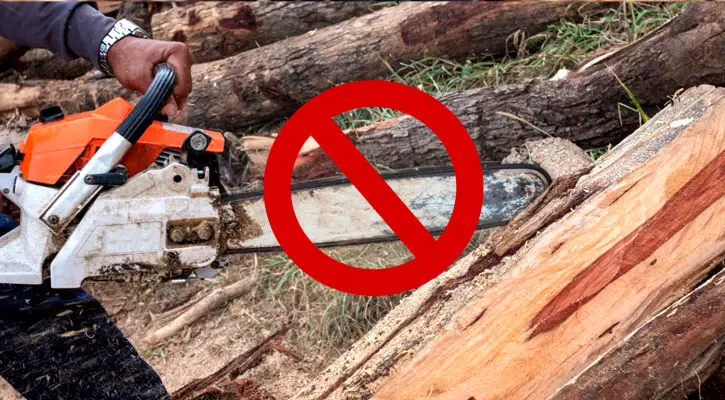
How to Reduce Chainsaw Kickback?
Now that you know what is chainsaw kickback and the top factors that cause it, we can now talk about some steps you can take to reduce your chances of experiencing a kickback.
Those include:
- Before using a new chainsaw, make sure to read the operating instructions in their entirety. Don’t assume that every chainsaw works exactly the same. Educate yourself on the proper way to handle the equipment you have.
- Always be awake and alert when using the chainsaw. Never use a chainsaw if you’re feeling fatigued.
- Double-check that the chain brake on your saw works before you start cutting.
- Never cut with the tip of the chain. This is considered the “kickback zone”.
- Be overly cautious when removing tree branches. If the nose bar strikes anything, including stumps, hidden branches, or logs, this could cause the chainsaw to kickback.
- Never use the chainsaw above shoulder height. You have less control over the tool and might not be able to stop a sudden backward thrust of the blade.
- When felling a tree (cutting it down), always use the bottom side of the bar to make your cuts. Never cut with the top of the bar.
- When felling a tree or crosscutting wood, consider boring the base of the chainsaw into the trunk or log. Many chainsaws include bucking spikes to help stabilize the tool and prevent sudden kickbacks.
- Always know where the nose of your chainsaw is and how it’s positioned.
- Consider using a low-kickback chain on your chainsaw.
- Use chainsaws that have narrow nose bars. Remember, the larger the nose bar is, the greater the chance of experiencing kickback.
- Always wear the right chainsaw protective gear and equipment to protect yourself while using a chainsaw. The items you should be wearing include:
- Protective eyewear
- Chainsaw chaps or pants
- Chainsaw gloves
- A hard hat (if you get a helmet with a face shield, this will keep your eyes protected and you won’t need separate safety glasses)
- Earmuffs or earplugs
- Heavy work boots (you might consider wearing logging boots that are made specifically for chainsaw work)
- Always keep your fingers wrapped tightly around your chainsaw handles. Using a half-grip doesn’t give you as much control over the tool.
- Make sure you follow the maintenance instructions that are provided with your chainsaw and chain to keep both in proper working condition.
What is an Anti-Kickback Chain (Low-Kickback Chain)?
Since chainsaw kickback is such a common occurrence—and a dangerous one—some chains have been designed to minimize this reactive force.
These types of chains are called “anti-kickback” or “low-kickback” chains.
These low-kickback chains work by putting a limit on the amount of wood fiber that can be hooked as the working corner rounds the upper half of the bar (i.e. the kickback zone).
This limitation is accomplished by adding extra metal to the tie straps between the cutting teeth.
This results in the tie strap functioning at a higher depth gauge as it goes around the top of the bar.
Some of the other ways that low-kickback chains reduce the chances of kickback occurring include having drive links with built-in bumpers and ramped depth gauges, which deflect the fiber to a certain extent as the chain travels through the kickback zone.
Your chainsaw can also be equipped with other features to reduce the chances of kickback occurring.
These include:
- Chain brake that stops the chain from spinning when a kickback happens.
- Front hand guard to protect your top hand from accidental cuts. This often doubles as the chain brake if you chainsaw has that safety feature.
- Tip guard that’s installed on the front of the chainsaw bar to prevent you from using that area to cut wood.
Summary of Chainsaw Kickback
As you learned, kickback can happen at any time, and withing a split second. Also, chainsaw kickback is the most common type of chainsaw injury that people encouter.
So, it pays to stay safe while operating your tool.
I hope this article answered all of your questions about what is chainsaw kickback, what causes chainsaw kickback, and methods to avoid it.
Happy sawing!
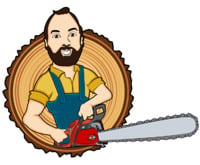
Your pal,
Chainsaw Larry
